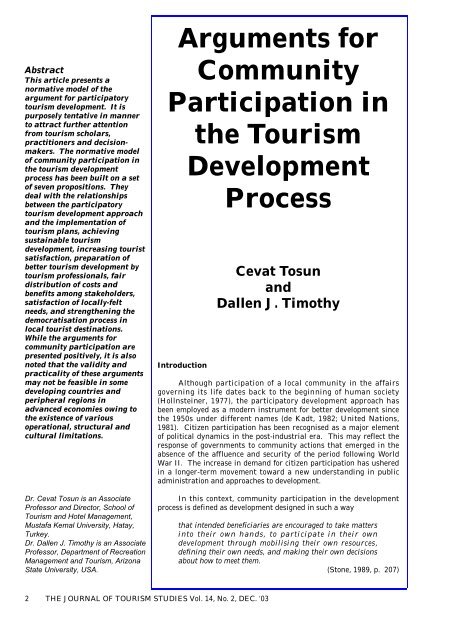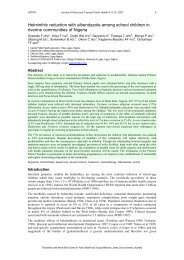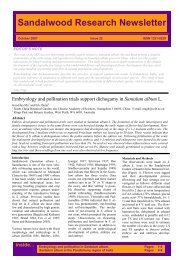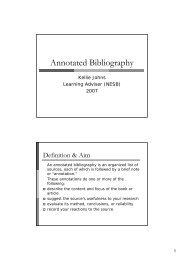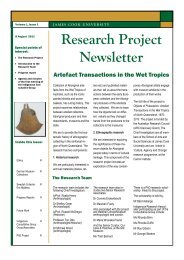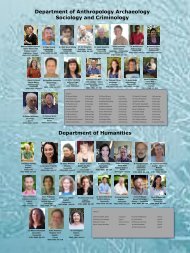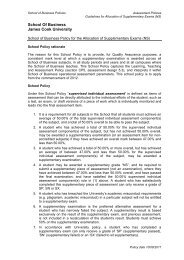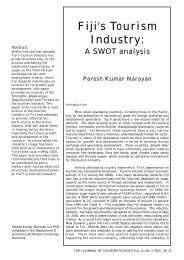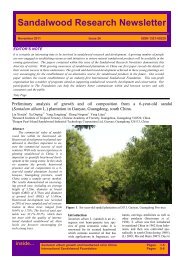Tosun Timothy
Tosun Timothy
Tosun Timothy
You also want an ePaper? Increase the reach of your titles
YUMPU automatically turns print PDFs into web optimized ePapers that Google loves.
Abstract<br />
This article presents a<br />
normative model of the<br />
argument for participatory<br />
tourism development. It is<br />
purposely tentative in manner<br />
to attract further attention<br />
from tourism scholars,<br />
practitioners and decisionmakers.<br />
The normative model<br />
of community participation in<br />
the tourism development<br />
process has been built on a set<br />
of seven propositions. They<br />
deal with the relationships<br />
between the participatory<br />
tourism development approach<br />
and the implementation of<br />
tourism plans, achieving<br />
sustainable tourism<br />
development, increasing tourist<br />
satisfaction, preparation of<br />
better tourism development by<br />
tourism professionals, fair<br />
distribution of costs and<br />
benefits among stakeholders,<br />
satisfaction of locally-felt<br />
needs, and strengthening the<br />
democratisation process in<br />
local tourist destinations.<br />
While the arguments for<br />
community participation are<br />
presented positively, it is also<br />
noted that the validity and<br />
practicality of these arguments<br />
may not be feasible in some<br />
developing countries and<br />
peripheral regions in<br />
advanced economies owing to<br />
the existence of various<br />
operational, structural and<br />
cultural limitations.<br />
Dr. Cevat <strong>Tosun</strong> is an Associate<br />
Professor and Director, School of<br />
Tourism and Hotel Management,<br />
Mustafa Kemal University, Hatay,<br />
Turkey.<br />
Dr. Dallen J. <strong>Timothy</strong> is an Associate<br />
Professor, Department of Recreation<br />
Management and Tourism, Arizona<br />
State University, USA.<br />
2 THE JOURNAL OF TOURISM STUDIES Vol. 14, No. 2, DEC. ‘03<br />
Arguments for<br />
Community<br />
Participation in<br />
Introduction<br />
the Tourism<br />
Development<br />
Process<br />
Cevat <strong>Tosun</strong><br />
and<br />
Dallen J. <strong>Timothy</strong><br />
Although participation of a local community in the affairs<br />
governing its life dates back to the beginning of human society<br />
(Hollnsteiner, 1977), the participatory development approach has<br />
been employed as a modern instrument for better development since<br />
the 1950s under different names (de Kadt, 1982; United Nations,<br />
1981). Citizen participation has been recognised as a major element<br />
of political dynamics in the post-industrial era. This may reflect the<br />
response of governments to community actions that emerged in the<br />
absence of the affluence and security of the period following World<br />
War II. The increase in demand for citizen participation has ushered<br />
in a longer-term movement toward a new understanding in public<br />
administration and approaches to development.<br />
In this context, community participation in the development<br />
process is defined as development designed in such a way<br />
that intended beneficiaries are encouraged to take matters<br />
into their own hands, to participate in their own<br />
development through mobilising their own resources,<br />
defining their own needs, and making their own decisions<br />
about how to meet them.<br />
(Stone, 1989, p. 207)
Clearly, public participation is a<br />
powerful tool to educate the<br />
community in rights, laws and<br />
political prudence. Participation<br />
is a development instrument and,<br />
more broadly, a body of influence,<br />
which is capable of undermining<br />
the related vices of ignorance,<br />
indolence and class conflict.<br />
Moreover, it is contended that<br />
since the leadership of society<br />
would inevitably be in the<br />
hands of an elite, it was<br />
necessary to ensure that its<br />
members were educated in the<br />
broadest sense and deeply<br />
valued individual liberty and<br />
democracy. The individual<br />
would, therefore, learn the<br />
politics of democracy by<br />
participating in local<br />
institutions and associations<br />
(Low, 1991, p. 86).<br />
We do not learn to read or<br />
write, to ride or swim, by<br />
merely being told how to do it<br />
but by doing it, so it is only by<br />
practicing popular government<br />
on a limited scale, that people<br />
will ever learn how to exercise it<br />
on a large scale.<br />
(Mill, 1973, p. 186, cited<br />
in Low, 1991, p. 86).<br />
On the basis of this argument, it<br />
is proposed that active and direct<br />
participation of local people in<br />
local affairs is an indispensable<br />
tool for public education<br />
(<strong>Timothy</strong>, 2000), without which,<br />
democracy and individual liberty<br />
cannot function.<br />
<strong>Tosun</strong> (2000, pp. 616-617) argued<br />
that<br />
the infrastructures of<br />
community participation are<br />
the legacies of western ideology;<br />
the influence of community<br />
development programs in<br />
developing countries; western<br />
social work and community<br />
radicalism; and the United<br />
Nations’ (UN) participatory<br />
development programs, which,<br />
indeed, provided a source of<br />
inclination for community<br />
participation as a modern<br />
concept in housing, transpor-<br />
tation, education, health, etc.<br />
Naturally, accumulations of<br />
participatory experiences in<br />
social, political and economic<br />
life have become the modern<br />
sources of inclination for<br />
community participation in the<br />
tourism development process.<br />
Proponents of participatory<br />
tourism development have<br />
studied community empowerment<br />
in the tourism development<br />
process in great detail and<br />
improved significantly its<br />
conceptual foundation (Gunn,<br />
1988; Haywood, 1988; Keogh,<br />
1990; Murphy, 1985; Reed, 1997;<br />
Scheyvens, 2002; Simmons, 1994;<br />
<strong>Timothy</strong>, 1999; <strong>Timothy</strong> & <strong>Tosun</strong>,<br />
2003; <strong>Tosun</strong>, 1999, 2000).<br />
However, these scholars appear<br />
to consider this pro-active<br />
approach in a reactive manner.<br />
This may be owing to the fact<br />
that arguments for communitybased<br />
tourism development have<br />
not been examined and discussed<br />
on their own in a systematic way.<br />
Therefore, the current status of<br />
arguments for community-driven<br />
tourism appears to be<br />
underdeveloped. However, a<br />
critical review of tourism<br />
literature and developmental<br />
studies reveals that a set of<br />
strong arguments might be<br />
developed by taking into account<br />
distinguished characteristics of<br />
the tourism industry. Within this<br />
context, the main objective of this<br />
article is to develop a set of<br />
propositions as a framework for<br />
understanding participatory<br />
tourism development. After a<br />
brief conceptual description of<br />
community participation and<br />
arguments for it in general, the<br />
article focuses on a set of<br />
arguments for grassroots<br />
participation in the tourism<br />
development process. The study<br />
then draws several conclusions<br />
based on the forgoing analysis.<br />
Because there are relatively few<br />
examples of participatory tourism<br />
development in the real world,<br />
not every contention is supported<br />
by empirical evidence. As a<br />
result, by nature, this article is<br />
somewhat tentative as it<br />
attempts to increase the debate/<br />
discussion about communitybased<br />
tourism development.<br />
Scope of arguments for<br />
community participation<br />
Community participation as an<br />
end and means has been<br />
examined from political, sociological,<br />
environmental, geographical,<br />
bureaucratic, management,<br />
economic and tourism development<br />
perspectives. Thus,<br />
scientists from many disciplines<br />
have contributed to the evolution<br />
and understanding of the concept<br />
of community participation. As a<br />
result, the meaning and scope of<br />
community empowerment have<br />
varied according to the goals of<br />
the users and the socio-political,<br />
cultural and economic conditions<br />
in which it is used. Therefore, it<br />
may be correct to state that<br />
community participation is not<br />
a simple matter of faith but a<br />
complex issue involving<br />
different ideological beliefs,<br />
political forces, administrative<br />
arrangements and varying<br />
perceptions of what is possible.<br />
(Midgley, Hall, Hardiman &<br />
Narine, 1986, p. ix).<br />
The wide differences in rationalities<br />
between the social actors<br />
engaged in encounters reflect that<br />
these actors often appear to be<br />
following scripts in separate,<br />
incompatible dramas, indifferent<br />
to, or contemptuous of, one<br />
another (Stiefel & Wolfe, 1994).<br />
Hollnsteiner (1977) has argued<br />
that people’s participation in<br />
formulating the kinds of<br />
communities where they live goes<br />
beyond a simple reference to<br />
traditional ideological debate<br />
about participatory development.<br />
These arguments show that<br />
participation as a development<br />
strategy is not an end itself, nor<br />
is it simply a tool for accelerating<br />
economic growth, which is often<br />
incorrectly presented as<br />
'development' in political<br />
platforms and social daily life.<br />
Hollnsteiner (1977) and White<br />
(1982) argued that community<br />
THE JOURNAL OF TOURISM STUDIES Vol. 14, No. 2, DEC. ‘03 3
participation is an instrumental<br />
end, which is aimed at achieving<br />
ultimate community goals. The<br />
ultimate goal is 'development',<br />
defined as a<br />
multidimensional process<br />
involving major change in<br />
social structures, popular<br />
attitudes, and national<br />
institutions, as well as the<br />
acceleration of economic<br />
growth, the reduction of<br />
inequality, and the eradication<br />
of absolute poverty.<br />
Development in its essence,<br />
must represent the whole gamut<br />
of change by which an entire<br />
social system, tuned to the<br />
diverse basic needs and desires<br />
of individuals and social<br />
groups within that system,<br />
moves away from a condition of<br />
life widely perceived as<br />
unsatisfactory and toward a<br />
situation or condition of life<br />
regarded as materially and<br />
spiritually better.<br />
(Todaro, 1989, p. 89)<br />
Naturally, different arguments<br />
have emerged for community<br />
participation in development<br />
among scholars and practitioners<br />
from diverse disciplines. White<br />
(1982, p. 20) outlined nine<br />
different but interrelated and<br />
interdependent arguments to<br />
support the importance and<br />
necessity of community<br />
participation in the development<br />
process. These are as follows:<br />
• More will be accomplished<br />
• Services can be provided at<br />
lower cost<br />
• Participation has an intrinsic<br />
value for participants<br />
• It is a catalyst for further<br />
development efforts<br />
• Participation leads to a sense<br />
of responsibility for the project<br />
• It guarantees that a felt need<br />
is involved<br />
• Participation ensures things<br />
are done in the right way<br />
• It uses indigenous knowledge<br />
and expertise<br />
• It frees communities from<br />
dependence on professionals.<br />
Indeed, Hollnsteiner (1977)<br />
raised arguments in favour of<br />
community participation before<br />
White's argument. Hollnsteiner<br />
(1977, p. 13) contended that<br />
involving people in the decisions<br />
that affect their own lives is<br />
significant for several reasons:<br />
a sense of responsibility<br />
through direct involvement,<br />
rectification of planners'<br />
misconceptions and general<br />
increase in community's selfreliance.<br />
Boaden, Goldsmith, Hampton &<br />
Stringer (1982) approached the<br />
issue from a public administration<br />
point of view. They<br />
argued that four main reasons<br />
have made community participation<br />
necessary as an<br />
alternative strategy at the local<br />
level. These reasons are<br />
functional fragmentation of public<br />
administration, centralisation of<br />
local government, professionalisation<br />
of service provision, and<br />
the increasing remoteness of<br />
government from people.<br />
However, it should be kept in<br />
mind that these issues were<br />
conceptualised in the United<br />
Kingdom in the early 1980s.<br />
Thus, these reasons may not be<br />
equally valid for other countries<br />
today. This might suggest that<br />
the grounds for public<br />
participation may change<br />
according to socio-cultural and<br />
political conditions and level of<br />
economic development. Although<br />
these arguments have been<br />
studied with special reference to<br />
health, education, rural development<br />
and transportation, they<br />
have not been examined in the<br />
context of tourism. Thus, the aim<br />
of this paper is to examine these<br />
issues and arguments from a<br />
tourism perspective.<br />
Arguments for community<br />
participation in the tourism<br />
development process<br />
As previously noted, the legacy of<br />
western ideology, the influence of<br />
community development<br />
programs in developing countries,<br />
and western social work and<br />
community radicalism as<br />
4 THE JOURNAL OF TOURISM STUDIES Vol. 14, No. 2, DEC. ‘03<br />
historical antecedents of participatory<br />
development provided an<br />
inclination toward community<br />
participation as a modern concept<br />
in housing, transportation,<br />
education, and health. To<br />
Midgley (1986b), community<br />
participation emerged as a viable<br />
development approach consequent<br />
to various UN participatory<br />
development programs. These<br />
historical antecedents of<br />
community participation may<br />
also be seen as a source of<br />
aspiration for public participation<br />
in the tourism development<br />
process. Since popular involvement<br />
has been previously used as<br />
a development strategy in other<br />
areas of social, political, and<br />
economic life, it has also provided<br />
guidelines in the context of<br />
tourism. Indeed, arguments for<br />
community-based tourism may<br />
have different explanations,<br />
which could stem directly from<br />
features of the tourism industry<br />
specifically. Arguments for the<br />
participatory development<br />
approach are considered under<br />
seven sub-headings and seven<br />
tentative propositions. It should<br />
be noted that these cases for<br />
participatory tourism development<br />
are not mutually exclusive.<br />
Proposition 1: Community<br />
participation is a vital element in<br />
the implementation of tourism<br />
plans and strategies.<br />
Public participation stimulates<br />
the formulation of implementable<br />
policies, the assumption being<br />
that if community members<br />
believe they have a say in a fair<br />
and open process of policy and<br />
plan development they may be<br />
willing to accept the outcome of<br />
that process (Buck, 1984;<br />
<strong>Timothy</strong>, 1999). Grassroots<br />
empowerment is an essential<br />
element in formulating comprehensive<br />
plans and an important<br />
tool in ensuring their feasibility.<br />
In future if the bureaucracy just<br />
makes the plan as if the citizens<br />
did not exist, it will be hard to<br />
get citizen understanding and<br />
co-operation.<br />
(Broadbent, 1988, p. 139).
Plumlee, Starling & Kramer<br />
(1985) and Haywood (1988)<br />
supported this assertion, that<br />
community members must be<br />
involved in and lead plan<br />
formulation, including determining<br />
goals in order to arouse<br />
community support that will<br />
ultimately lead to acceptance and<br />
implementation of the plan.<br />
The outcome of numerous tourism<br />
impact and resident attitude<br />
studies in tourist destinations<br />
has been a call for increased<br />
public participation and, in<br />
particular, a more communityoriented<br />
approach to tourism<br />
planning.<br />
(Keogh, 1990, p. 450)<br />
According to the Department of<br />
Economic and Social Affairs of<br />
the United Nations Secretariat<br />
(1971, p. 61),<br />
Where the targets of a plan are<br />
not fully realised this is often<br />
attributed as much to<br />
inadequate public involvement.<br />
The World Tourism Organization<br />
(WTO) (1980) established an<br />
inventory of 1619 assorted<br />
tourism plans in 1980. The<br />
survey concluded that only 66.5%<br />
have been implemented. Nearly<br />
half (43.5%) of the plans were<br />
categorised as unimplementable.<br />
In this regard, <strong>Tosun</strong> (1998)<br />
argues that although there are<br />
various reasons for unimplemented<br />
plans, which can vary<br />
from place to place, an analysis of<br />
the evolution of tourism planning<br />
and tourism literature suggests<br />
that community participation has<br />
not even been considered in<br />
tourism plans during the 1980s<br />
and 90s.<br />
The public now demands that<br />
their concerns be incorporated<br />
into the decisions-making<br />
process. However, there has<br />
been little public involvement in<br />
tourism planning.<br />
(Mathieson & Wall, 1982, p.181)<br />
This appears to be a natural<br />
consequence of the over centrali-<br />
sation of tourism planning and<br />
destination management. As<br />
<strong>Timothy</strong> (1999) and <strong>Tosun</strong> (2000)<br />
contend with special reference to<br />
developing countries, most<br />
tourism development plans have<br />
been prepared by central<br />
authorities who may not be aware<br />
of conditions under which the<br />
plans will be implemented at<br />
local levels by their regional<br />
or/and local extensions. Thus,<br />
planning and developing with<br />
local authorities and communities<br />
rather than for them may help<br />
central bodies know what local<br />
resources are available for<br />
tourism development. Alluding to<br />
this kind of situation, Murphy<br />
(1983, p. 188) stated,<br />
the lack of sufficient consultation<br />
and planning at the local<br />
level has certainly contributed<br />
to the delay and demise of<br />
many projects and policies<br />
proposed by central planning<br />
agencies.<br />
Public participation in the<br />
planning process and plan<br />
implementation is important<br />
owing to the fact that tourism<br />
development takes place in<br />
existing and well-established<br />
socio-cultural, political, economic,<br />
and administrative environments.<br />
For some forms of alternative and<br />
special interest tourism, sociocultural<br />
and environmental<br />
considerations are particularly<br />
sensitive, and participation of the<br />
local community in planning and<br />
implementation is necessary to<br />
ensure that the industry benefits<br />
the local community and is not<br />
disruptive to its everyday life<br />
(Inskeep, 1991). In brief, without<br />
citizen support, implementing<br />
even the best-prepared plan may<br />
be very difficult (van Harssel,<br />
1994). This implies that success<br />
in tourism development depends<br />
on strong community support<br />
(Getz, 1983).<br />
Proposition 2: Community<br />
participation contributes to<br />
sustainable tourism development<br />
in several ways.<br />
Many students of tourism have<br />
supported this proposition.<br />
Particularly since the publication<br />
of Murphy's (1985) book,<br />
Tourism: A community approach,<br />
the concept of community<br />
participation in tourism development<br />
has become a central issue<br />
in the debate on sustainability.<br />
In this regard, Woodley (1993, p.<br />
137) states<br />
a community-based approach to<br />
tourism development is prerequisite<br />
to sustainability.<br />
It has also been contended that<br />
An important aspect of<br />
sustainable development is<br />
emphasising community-based<br />
tourism. This approach to<br />
tourism focuses on community<br />
involvement in the planning<br />
and development process, and<br />
developing the types of tourism,<br />
which generate benefits to local<br />
communities. It accrues to<br />
local residents and not to<br />
outsiders. Maximising benefits<br />
to local residents typically<br />
results in tourism being better<br />
accepted by them and their<br />
actively supporting conservation<br />
of local resources.<br />
(Inskeep, 1994, p. 8)<br />
It is commonly noted that the<br />
more that community residents<br />
benefit from tourism, the more<br />
likely they will be to protect the<br />
area's natural and cultural<br />
heritage and support tourism<br />
activities (McIntyre, Hetherington<br />
& Inskeep, 1993; <strong>Timothy</strong>,<br />
1999). On the other hand,<br />
community involvement in<br />
establishing desirable conditions<br />
is perhaps the single<br />
most important element of<br />
growth management in tourist<br />
destinations.<br />
(Williams & Gill, 1994, p. 184)<br />
Pearce (1994) noted that<br />
community involvement represents<br />
a technique for limiting<br />
negative social impacts. Ryan<br />
and Montgomery (1994, p. 369)<br />
asserted,<br />
communities need only to be<br />
THE JOURNAL OF TOURISM STUDIES Vol. 14, No. 2, DEC. ‘03 5
educated about the benefits of<br />
tourism, and that their<br />
involvement in good visitor<br />
management techniques will<br />
actually solve problems.<br />
That is to say, a reasonable<br />
degree of consensus, which might<br />
be reached via public participation,<br />
is requisite for<br />
sustainable tourism development.<br />
The limits of local tolerance to<br />
tourism can be increased through<br />
resident participation, thereby<br />
potentially increasing social<br />
carrying capacity as well<br />
(D'Amore, 1983; <strong>Tosun</strong>, 2002).<br />
This is defined as<br />
that point in the growth of<br />
tourism where local residents<br />
perceive, on balance, an<br />
unacceptable level of social<br />
disbenefits from tourist<br />
development.<br />
(D'Amore, 1983, p. 144)<br />
In other words, communities have<br />
a limited capacity to absorb<br />
tourists. Growth beyond this<br />
threshold may result in negative<br />
social or ecological impacts and<br />
diminishing returns on<br />
investments (Allen, Long, Perdue<br />
& Kieselbach, 1988). As Murphy<br />
(1985, p. 153) puts it,<br />
tourism … relies on the<br />
goodwill and cooperation of<br />
local people because they are<br />
part of its product. Where<br />
development and planning do<br />
not fit in with local aspirations<br />
and capacity, resistance and<br />
hostility can … destroy the<br />
industry’s potential altogether.<br />
Many tourist destinations were<br />
undeveloped rural areas prior to<br />
the growth of tourism, which may<br />
imply that historically local<br />
communities in tourist destinations<br />
were marginalised from<br />
socio-economic and political life in<br />
relative terms. This lack of<br />
experience makes community<br />
control over resources difficult.<br />
On the other hand, no matter how<br />
much substantive knowledge<br />
exists on a particular subject, and<br />
no matter how we develop our<br />
capabilities in information<br />
handling, operation research, and<br />
prediction, if there is little<br />
opportunity to develop a community's<br />
capacity for improved<br />
decision-making within the<br />
framework of a democratic<br />
process, there is a real possibility<br />
that large investments in<br />
planning will have been in vain<br />
(Fagence, 1977). Community<br />
participation may help the<br />
industry contribute to national<br />
development better in the long<br />
term if local people have a voice<br />
in decision-making (<strong>Tosun</strong>, 1998).<br />
In this way, the participatory<br />
approach can be an instrument<br />
for economic growth and<br />
sustainable development at both<br />
local and national levels.<br />
Additionally, the participatory<br />
development strategy can be used<br />
as a tool to improve a community's<br />
capacity for making<br />
decisions within the democratic<br />
process. This is badly needed,<br />
particularly in the developing<br />
world.<br />
In brief, this argument suggests<br />
that community involvement has<br />
become an indispensable part of<br />
sustainable tourism development<br />
since it has the potential to help<br />
protect and preserve sociocultural,<br />
historical and natural<br />
resources essential for tourist<br />
experiences, achieve a more<br />
equitable distribution of tourism<br />
costs and benefits among<br />
stakeholders, and increase the<br />
mutual benefits among tourists<br />
and destination residents by<br />
building a better understanding<br />
between them.<br />
Proposition 3: Community<br />
participation increases tourist<br />
satisfaction<br />
Tourism itself will probably not<br />
be sustainable without a<br />
sufficient number of satisfied<br />
customers. If the visitor does not<br />
feel that a place is worth a visit<br />
then it will wane in popularity<br />
(Cooper, 1993). Since destination<br />
communities are accepted and<br />
promoted as an important<br />
component of the product, there<br />
should be no doubt that tourists’<br />
6 THE JOURNAL OF TOURISM STUDIES Vol. 14, No. 2, DEC. ‘03<br />
satisfaction will be affected by the<br />
willingness, or lack thereof, of<br />
community members to support<br />
the industry, which may be<br />
determined by how much they<br />
benefit from tourism development.<br />
As D'Amore (1983, p. 143)<br />
stated,<br />
another component of supply of<br />
tourism resources is the<br />
attitudes and behaviour of the<br />
hosts, since these qualities form<br />
a significant part of the tourist<br />
experience.<br />
Another advocate of participatory<br />
tourism development has argued<br />
that<br />
while all scales of planning are<br />
important for tourism<br />
development, planning at the<br />
community level is vital if any<br />
region wishes to deliver tourism<br />
experiences which ensure both<br />
visitor satisfaction and ongoing<br />
benefits for the residents of<br />
destinations areas.<br />
(Simmons, 1994, p. 99)<br />
Taylor (1995, p. 488) observed<br />
that a<br />
friendly community is desirable<br />
for all kinds of inward<br />
investment but for the tourist<br />
destination it is the stuff of<br />
advertising.<br />
Alluding to local hospitality and<br />
friendliness, Wood (1994) points<br />
out that what is consumed by<br />
tourists, except some specific<br />
services (e.g., bed and breakfasts)<br />
remains largely undefined.<br />
Indeed, the undefined part,<br />
largely the local flavour, may be<br />
the most important component of<br />
the tourism product. Tourists can<br />
buy another breakfast and switch<br />
their hotels, but changing<br />
destinations is difficult because<br />
most of them have very limited<br />
time and money. Moreover, unsatisfactory<br />
holiday experiences<br />
may mean dissatisfaction for the<br />
entire year since tourists perceive<br />
holidays as a necessity and way of<br />
coping with job stress. The<br />
participatory development<br />
strategy may be a means of
increasing the tangibility of an<br />
intangible tourism product and<br />
improving tourist satisfaction by<br />
creating a reasonable consensus<br />
between tourism and the host<br />
community, which may motivate<br />
local people to be more<br />
hospitable. In other words,<br />
participation in tourism planning<br />
may create a sense of ownership<br />
among residents - that it was<br />
their own decision to develop<br />
tourism in its present form.<br />
Public involvement may also be<br />
used to maintain a unique<br />
lifestyle, fulfil residents'<br />
aspirations, and prevent<br />
alteration of destination qualities<br />
to suit tourist expectations.<br />
Thus, visitor satisfaction will<br />
increase as they seek places that<br />
are unique and different from<br />
their own communities.<br />
In brief, this discussion suggests<br />
that building mutually desirable<br />
and beneficial relationships<br />
through participatory development<br />
may increase satisfaction of<br />
both hosts and guests during<br />
their temporary encounter.<br />
Proposition 4: Community<br />
participation helps tourism<br />
professionals design better<br />
tourism plans.<br />
It has been noted that<br />
the tendency of professional<br />
self-interests to produce<br />
bureaucracy is by now a setpiece<br />
of sociology.<br />
(Tillotson, 1994, p. 512)<br />
Thus, reordering priorities within<br />
the planning and economic<br />
development professions may be<br />
necessary. Planning for people is<br />
now old fashioned, while planning<br />
with and by people is in style<br />
(Robinson & Shaw, 1991). Public<br />
participation provides additional<br />
local insight for architects,<br />
planners, and administrators<br />
directly involved in development<br />
projects. Low-income groups and<br />
other traditionally marginalised<br />
groups in society can give their<br />
middle and upper class counterparts<br />
new insights. This is not an<br />
easy task, for after years of<br />
technical training, the planning<br />
specialist sometimes loses his/her<br />
capacity to empathise with the<br />
viewpoints of other social classes.<br />
Professional training of elite<br />
specialists commonly engenders<br />
an attitude of knowing best,<br />
but, by failing to involve the<br />
ordinary people, these<br />
developers impose external<br />
solutions and foster paternalism;<br />
they also frequently<br />
make mistakes that are<br />
monumentally costly and<br />
wasteful.<br />
(Midgley, 1987, p. 10)<br />
Thus, people's participation<br />
might rectify planning errors by<br />
making it possible for clients to<br />
explain to technicians-managers<br />
what will work and what will not<br />
in local conditions. It is a wise<br />
listener who takes these points<br />
seriously and evaluates plans and<br />
programs accordingly (Boaden e t<br />
a l., 1982). What an Australian<br />
Aboriginal woman said is<br />
relevant to the issue:<br />
If you have come to help me;<br />
You can go home again; But if<br />
you see my struggle; as part of<br />
your own survival; Then<br />
perhaps we can work together.<br />
(ANGOC, 1989, p. 4, quoted in<br />
Colchester, 1994, p. 69)<br />
Since the emergence of tourism as<br />
an economic phenomenon in<br />
many developing countries,<br />
tourism developers have pushed<br />
the process to maximise economic<br />
benefits by attracting the highest<br />
possible numbers of visitors and<br />
building tourism infrastructure<br />
(<strong>Tosun</strong>, 2001). Particularly in<br />
developing countries, tourism<br />
plans have been prepared by<br />
central governments as though<br />
local communities do not exist,<br />
resulting in a missing, but<br />
critical, ingredient (<strong>Timothy</strong>,<br />
1999; <strong>Timothy</strong> & White, 1999;<br />
<strong>Tosun</strong>, 2000). This may be a<br />
result of the fact that<br />
tourism planners are generally<br />
persons with qualifications in<br />
urban and regional planning,<br />
urban design, or landscape<br />
architecture who have evolved a<br />
specialisation in tourism and<br />
resort planning through<br />
experience.<br />
(Inskeep, 1988, p. 370)<br />
Inskeep (1988, p. 370) states that<br />
The planners or the government<br />
should involve the residents in<br />
the decision making process of<br />
developing tourism and give<br />
them sufficient opportunities to<br />
receive its benefits through<br />
employment at all levels, easy<br />
access to tourist facilities and<br />
attractions, and equity<br />
ownership of facilities and<br />
services... Planners should<br />
develop tourism gradually so<br />
that residents have sufficient<br />
time to understand and adapt<br />
to it, and the scale of tourism<br />
should remain at a level that<br />
allows the society to cope with<br />
it.<br />
Grassroots participation as a<br />
catalyst instrument builds a<br />
relationship among planners,<br />
decision makers and local<br />
communities. It creates opportunities<br />
for tourism professionals<br />
to go beyond traditional bureaucratic<br />
paternalism, wherein<br />
agencies and technocrats believe<br />
they understand the desires of<br />
community members, and they<br />
alone know what is best for<br />
destination residents. On the<br />
other hand, tourism professionals<br />
can use community views<br />
generated through empowering<br />
activities as input for tourism<br />
plans and as a base to persuade<br />
decision-makers to implement<br />
participatory tourism development.<br />
The above argument suggests<br />
that<br />
central to this communitydriven<br />
tourism planning is an<br />
explicit recognition that experts<br />
cannot judge the perceptions,<br />
preferences or priorities of host<br />
communities.<br />
(Pearce, Moscardo & Ross,<br />
1996, pp. 10-11)<br />
THE JOURNAL OF TOURISM STUDIES Vol. 14, No. 2, DEC. ‘03 7
A present-oriented mentality<br />
makes it difficult for tourism<br />
professionals to project beyond<br />
current needs and problems.<br />
Hence, public participation may<br />
generate invaluable input for<br />
planners to prepare a better<br />
development plan for sustainable<br />
tourism development.<br />
Proposition 5: Public<br />
participation contributes to a fair<br />
distribution of costs and benefits<br />
among community members.<br />
Tourism development generates<br />
social, cultural, economic and<br />
environmental costs and benefits.<br />
However, these have not been<br />
distributed fairly among stakeholders<br />
because of the disconnection<br />
between local people,<br />
tourism, and power structures<br />
among interest groups.<br />
Eadington and Smith (1992)<br />
argued that the current style of<br />
tourism development has already<br />
created 'winners' and 'losers'<br />
among local people. Furthermore,<br />
many of the 'winners' in<br />
third world resort communities<br />
are outsiders who may be viewed<br />
as exploiters of the native<br />
population and rapists of the<br />
land. There may be, as the<br />
International Institute of<br />
Tourism Studies (1991, p. 9)<br />
reported,<br />
a need to recognise that tourism<br />
must benefit the local<br />
community and that there must<br />
be broad-based participation in<br />
tourism development decisions<br />
at the community level.<br />
Several scholars have recognised<br />
that local residents have received<br />
limited and unequal benefits from<br />
tourism although they must live<br />
with its negative consequences<br />
(e.g., Brohman, 1996; <strong>Timothy</strong>,<br />
1999; <strong>Tosun</strong>, 2001; Tsartas,<br />
1992). Contributing to this<br />
situation,<br />
tourism entrepreneurs within a<br />
community may not actually be<br />
part of that community. They<br />
may be 'off-comers', strangers<br />
who import qualities which do<br />
not and cannot stem from the<br />
group itself, or they may be in<br />
some ways marginal, perhaps<br />
better equipped to profit from<br />
tourist enterprises.<br />
(Taylor, 1995, p. 488)<br />
In some destinations, the<br />
environmental and socio-cultural<br />
costs of tourism development<br />
outweigh its economic benefits.<br />
The following statement provides<br />
evidence in this regard.<br />
Having ruined their own<br />
environment, having either<br />
used up or destroyed all that is<br />
natural people from the<br />
advanced consumer societies<br />
are compelled to look for<br />
natural wildlife, cleaner air,<br />
lush greenery and golden<br />
beaches elsewhere. In others<br />
words, they look for other<br />
environments to consume.<br />
Thus armed with their bags,<br />
tourists proceed to consume the<br />
environment in countries of the<br />
Third World - the last<br />
unspoiled corner of earth.<br />
(Hong, 1985, p. 12, quoted in<br />
Brohman, 1996, p. 58-59).<br />
We don't want tourism. We<br />
don't want you. We don't want<br />
to be degraded as servants and<br />
dancers. This is cultural<br />
prostitution. I don't want to see<br />
a single one of you in Hawaii.<br />
There are no innocent tourists.<br />
(Pfafflin, 1987, p. 577)<br />
This quote and the previous one<br />
show that local people in many<br />
tourist destinations perceive<br />
tourism negatively. Moreover,<br />
often international tourists are<br />
seen as exploitative, lavish, and<br />
hedonic foreigners who lack crosscultural<br />
understanding and<br />
communication skills (Din, 1989;<br />
Dogan, 1989).<br />
Tourism development diversifies<br />
previously homogeneous communities,<br />
and these communities<br />
exhibit different responses to the<br />
growth of the industry (Dogan,<br />
1989). Indeed, tourism not only<br />
creates heterogeneous communities,<br />
it also changes power<br />
structures in tourist destinations<br />
commonly at the expense of<br />
8 THE JOURNAL OF TOURISM STUDIES Vol. 14, No. 2, DEC. ‘03<br />
indigenous people who may be<br />
excluded from tourism development<br />
and decision making<br />
altogether. In this context, Hall<br />
and Jenkins (1995, p. 77) argue<br />
that<br />
awareness of the political<br />
dimensions of tourism, and<br />
more particularly the uneven<br />
allocation of power in a society<br />
or a community, should caution<br />
us about the representativeness<br />
of outcomes of tourism<br />
planning exercises.<br />
In some countries, particularly at<br />
the beginnings of tourism<br />
development, the domain of<br />
bargaining quickly becomes<br />
focused narrowly upon certain<br />
material reciprocities. Entrepreneurs<br />
seek an exaction fee for<br />
public space, an abatement of<br />
property tax and other<br />
development incentives. The<br />
rounds of negotiation continue<br />
without regard for long-term<br />
consequences: distributional<br />
inequities and externalities. For<br />
example, <strong>Tosun</strong> (2001) claims<br />
that the Turkish tourism<br />
industry received generous<br />
incentives during the 1980s,<br />
which may be partly due to<br />
pressures by private entrepreneurs<br />
on decision-makers,<br />
which has resulted in inequalities<br />
in the early 2000s. In many<br />
ways, tourism development has<br />
created a get rich mentality. The<br />
end product may be that local<br />
people increasingly come to feel<br />
alienated, and consider that<br />
tourists’ needs are catered to<br />
ahead of local needs, and that<br />
infrastructure and facilities are<br />
not available to locals (D'Amore,<br />
1983).<br />
These arguments suggest that<br />
many tourist destinations need<br />
an alternative approach to<br />
tourism development, which may<br />
spread both its costs and benefits<br />
equitably and which would be<br />
more sensitive to its sociocultural<br />
impacts. Moreover, a<br />
large proportion of local people<br />
should benefit from tourism<br />
rather than merely bearing its<br />
residual burdens. Community-
ased development may provide<br />
more opportunities for destination<br />
communities that have<br />
not yet reaped the benefits of<br />
tourism.<br />
Proposition 6: Community<br />
participation can help satisfy<br />
locally identified needs.<br />
It is important that tourism<br />
development patterns reflect the<br />
needs and desires of local<br />
communities (Inskeep, 1994).<br />
Several examples exist of projects<br />
that have failed when the real<br />
needs of community were not<br />
taken into account (cf. Bradley &<br />
Karunadasa, 1989). Thus,<br />
projects should be molded to meet<br />
people's needs, and not vice versa.<br />
While local people do need better<br />
hospitals, schools, houses and<br />
food, it may be naïve to suggest<br />
that tourism will necessarily and<br />
automatically address these<br />
needs. For example, Long (1991,<br />
p. 210) noted that in Santa Cruz,<br />
a burgeoning tourist destination<br />
in Mexico,<br />
Local infrastructure was in<br />
some aspect deficient and stores<br />
could not maintain adequate<br />
supplies and groceries for the<br />
burgeoning populace. Public<br />
transportation was inadequate;<br />
buses had sporadic schedules<br />
and taxis were usually full.<br />
Residents complained that a<br />
visit to the public clinic took an<br />
entire day, as there were<br />
insufficient facilities and staff<br />
for the demand. Medical<br />
services in the area had<br />
improved according to most of<br />
the respondents, but many were<br />
still dissatisfied with the<br />
services available. Many said<br />
they sought out private doctors<br />
in the town of Pochutla, an<br />
hour's bus ride away.<br />
[ M o r e o v e r ] the original<br />
residents of Santa Cruz did not<br />
have cars and had to walk the<br />
kilometer over the hill<br />
separating Santa Cruz and La<br />
Crucecia to visit people, go to<br />
work, seek out services or go to<br />
the stores that were divided<br />
between the communities. As<br />
they walked over the steep hill,<br />
cars and trucks raced by,<br />
forcing the pedestrians into the<br />
drainage ditch along the side of<br />
the road. The locals’ use of<br />
roads did not appear to have<br />
been considered in road design,<br />
as no sidewalks were installed.<br />
Participatory planning - something<br />
quite uncommon in<br />
developing societies - may help<br />
local people's needs (<strong>Timothy</strong>,<br />
1999; <strong>Tosun</strong>, 2000).<br />
Communities are the<br />
destination of most of<br />
travelers...it is in communities<br />
that tourism happens. Because<br />
of this, tourism industry<br />
development and management<br />
must be brought effectively to<br />
bear in communities.<br />
(Blank, 1989, p. 4)<br />
The empowerment of the<br />
destination community members<br />
is essential to maximise the socioeconomic<br />
benefits of tourism<br />
(Inskeep, 1991). The<br />
International Institute of<br />
Tourism Studies (1991, p. 9)<br />
claimed that<br />
resident responsive tourism is<br />
the watchword for tomorrow;<br />
community demands for active<br />
participation in the setting of<br />
the tourism agenda and its<br />
priorities for tourism<br />
development and management<br />
cannot be ignored.<br />
Community-oriented tourism<br />
development requires finding a<br />
way of creating more workable<br />
partnerships between the tourism<br />
industry and local communities<br />
and developing facilities both for<br />
hosts and guests (<strong>Timothy</strong>, 1998).<br />
The participatory approach leads<br />
to a greater sense of empowerment<br />
in addressing community<br />
problems, as well as greater<br />
ownership over the plans and<br />
activities that result from the<br />
community participation process.<br />
As a result, community<br />
participation will serve as an<br />
educational and empowering<br />
process for host communities to<br />
become partners with those able<br />
to assist them, identify problems<br />
and needs, and increasingly<br />
assume personal responsibility to<br />
plan, manage and control tourism<br />
development.<br />
Proposition 7: Community<br />
participation strengthens the<br />
democratisation process in tourist<br />
destinations.<br />
As part of the<br />
metamorphosis of the<br />
democratic process ... the<br />
residents of communities and<br />
regions affected by tourism are<br />
demanding to be involved in<br />
the decisions affecting their<br />
development.<br />
(Ritchie, 1993, p. 379).<br />
In this regard, community<br />
involvement in tourism development<br />
has become a new standard<br />
in tourism planning (Prentice,<br />
1993). The more participatory<br />
the tourism development process<br />
is, the more feedback and input in<br />
various forms will flow toward<br />
official bodies, which might<br />
narrow the gap between the<br />
community and bureaucratic<br />
decision-makers. Communication<br />
between communities and<br />
decision-makers must be a twoway<br />
process from the bottom up<br />
and the top down. This<br />
democratisation process has the<br />
potential to increase awareness<br />
and interest within the<br />
community about local and<br />
regional issues - something badly<br />
needed in many tourist<br />
destinations, particularly in<br />
developing countries. Initiating<br />
community participation and<br />
ultimately community control<br />
may be more crucial in developing<br />
countries than in developed<br />
countries since, as most scholars<br />
claim, democratic principles are<br />
all but completely non-existent in<br />
the less-developed world. In<br />
many less-developed countries<br />
tourism has become a priority<br />
sector in public policy owing to its<br />
considerable economic impact.<br />
This leads Jenkins (1980, p. 27) to<br />
argue that<br />
tourism in developed countries<br />
THE JOURNAL OF TOURISM STUDIES Vol. 14, No. 2, DEC. ‘03 9
can be regarded as a mainly<br />
social activity with economic<br />
consequences; in developing<br />
countries it is largely an<br />
economic activity with social<br />
consequences.<br />
As third world governments have<br />
placed paramount importance on<br />
tourism in public policy,<br />
alienation of community members<br />
from this sector may mean the<br />
alienation of people from<br />
economic, socio-cultural and even<br />
political life in some areas where<br />
tourism has become a major<br />
source of income and a dominant<br />
social activity.<br />
According to Wruth (1992, p.<br />
293), a popular government that<br />
does not seek popular input is<br />
a prologue to a farce or a<br />
tragedy and knowledge will<br />
forever govern ignorance: and a<br />
people who mean to be their<br />
own governors, must arm<br />
themselves with the power<br />
which knowledge gives.<br />
Empowerment is a way of gaining<br />
knowledge that may arm a<br />
community to challenge outside<br />
and elitist interests in tourist<br />
destinations.<br />
Community members are not only<br />
the consumers of public and<br />
private goods and services, they<br />
are also designers and producers<br />
of a product. Thus, as noted in<br />
Rose and Hanmer (1975, p. 33)<br />
variant democracy is very<br />
limited, in that it regards the<br />
citizen only as a 'consumer' and<br />
not as a 'doer’.<br />
In this regard, it is inadequate<br />
and unfair to package community<br />
values, beliefs and cultures and<br />
market them internationally<br />
without giving residents<br />
opportunities to decide on the<br />
scale and form of that product.<br />
To do otherwise is undemocratic,<br />
albeit commonplace. Thus,<br />
assessing the community's<br />
regional hopes, aspirations,<br />
and values requires reasonably<br />
high-quality and diverse public<br />
input if the views of those who<br />
value public involvement in the<br />
planning process as a desirable<br />
part of democracy are accepted.<br />
(Syme, Macpherson & Seligman,<br />
1991, p. 1780)<br />
Moreover, it is the process of<br />
political debate that determines<br />
appropriate policy in a democracy<br />
(Davidoff, 1965). Community<br />
involvement in the policy<br />
planning process and decisionmaking<br />
is an indispensable<br />
component of political debate.<br />
It is now commonly recognised<br />
that there is a growing global<br />
trend from centralised to<br />
decentralised power, where<br />
political control has moved away<br />
from central governments to<br />
lower order civil divisions (i.e.,<br />
states, cities, towns and<br />
neighbourhoods). This trend has<br />
begun giving opportunities to<br />
residents to deal with their own<br />
problems and concerns (Naisbitt,<br />
1984). It can be argued that the<br />
community tourism approach was<br />
ushered in by the decentralising<br />
trend, which results from real<br />
democratisation processes, and<br />
community involvement further<br />
encourages democratic governance.<br />
In this context, Davidoff<br />
(1965) argued that if democratic<br />
urban governance is encouraged<br />
by the planning process, citizen<br />
participation must be guided and<br />
supported in the planning<br />
process.<br />
Democratic theories have always<br />
considered participatory democracy<br />
a societal value, which<br />
advocates extensive direct<br />
participation in decision-making<br />
by as many members of the<br />
system as possible. It has long<br />
been accepted that selfdetermination<br />
by ordinary<br />
citizens and other stakeholders<br />
permits them to reach rational<br />
and effective decision-making and<br />
fulfil their potentials (Fong,<br />
1986). If community participation<br />
is accepted as a tourism<br />
development strategy, local<br />
people may articulate and realise<br />
their own interests and promote<br />
10 THE JOURNAL OF TOURISM STUDIES Vol. 14, No. 2, DEC. ‘03<br />
the stability and efficacy of social<br />
institutions in the tourist<br />
destination.<br />
In less-developed countries,<br />
although the poorest groups are<br />
in the majority, they are the least<br />
influential and seldom able to<br />
express their views. Their<br />
powerlessness is often conveniently<br />
interpreted as passivity<br />
and indifference, but the real<br />
problem is lack of opportunity for<br />
their direct involvement (Midgley,<br />
1986a). Also, state development<br />
programs tend to favour elite<br />
groups. If tourism is a crosscultural<br />
and international socioeconomic<br />
activity, and one of the<br />
biggest industries in the world,<br />
destination communities should<br />
be given opportunities to<br />
determine the scale and types of<br />
tourism development they wish to<br />
pursue. Rapid mass tourism<br />
growth threatens traditional<br />
people’s simple way of life by<br />
accelerating the process of<br />
modernisation and social change,<br />
something with which they may<br />
not be able to cope. By organising<br />
local people and making them<br />
aware of their situation,<br />
community participation provides<br />
a mechanism for the mobilisation<br />
of the masses and a collective<br />
means of redress (Midgley, 1986b;<br />
<strong>Timothy</strong>, 2000).<br />
In the context of tourism, it is<br />
accepted that<br />
the public’s right to participate<br />
in the planning activities that<br />
affect their daily life is now a<br />
widely accepted principle<br />
throughout the democratic<br />
world.<br />
(Simmons, 1994, p. 99)<br />
The tourism development process<br />
should lead to the participation of<br />
various groups from social classes<br />
that represent the diverse<br />
interests of the destination<br />
community.<br />
This would not only discourage<br />
undemocratic, top-down<br />
decision making, but also<br />
provide opportunities for<br />
communities to use their own
esources and popular<br />
creativity to find locally<br />
appropriate methods of tourism<br />
development.<br />
(Brohman, 1996, p. 61)<br />
In addition, since planning has a<br />
temporal dimension, planning by<br />
public authorities can become<br />
difficult and cumbersome owing<br />
to changes brought about by<br />
elections and other political<br />
transformations.<br />
This lends further support to<br />
the need to involve residents<br />
and other key stockholders into<br />
a flexible and dynamic<br />
planning process that can<br />
sustain the changing<br />
administration and adjust to<br />
other forces impacting on the<br />
tourism system<br />
(Jamal & Getz, 1995, p. 199)<br />
in a more democratic manner.<br />
Conclusion<br />
This paper has presented a set of<br />
normative arguments in favour of<br />
the participatory tourism<br />
development approach. It has<br />
purposefully taken an optimistic<br />
viewpoint and advocacy approach<br />
in an effort to highlight the<br />
benefits of participatory tourism<br />
development and attract the<br />
attention of tourism scholars,<br />
practitioners and decisionmakers.<br />
The arguments for<br />
community participation in<br />
tourism development were<br />
conceptualised around a set of<br />
seven propositions that deal with<br />
the relationships between<br />
participatory tourism development<br />
and the implementation of<br />
tourism plans, achieving<br />
sustainable tourism development,<br />
increasing tourist satisfaction,<br />
fair distribution of costs and<br />
benefits of tourism between<br />
involved stakeholders, satisfaction<br />
of local-felt-needs and<br />
strengthening democratisation<br />
process in local tourist<br />
destinations.<br />
Clearly, arguments developed in<br />
favour of participatory tourism<br />
development may not be found<br />
equally valid from every point of<br />
view. Some may be thought to<br />
apply in some localities and<br />
others in different ones, but they<br />
are not in general mutually<br />
exclusive, and taken together<br />
they make a sensible argument.<br />
It should be noted that<br />
community participation in the<br />
tourism development process has<br />
emerged and been refined in the<br />
context of developed countries.<br />
Advocates writing on developed<br />
countries have also popularised<br />
it. Therefore, these prescriptive<br />
and tentative propositions were<br />
developed for a participatory<br />
approach are essentially based<br />
upon theoretical frameworks and<br />
principles that planners from the<br />
developed world employ in<br />
tourism planning (<strong>Timothy</strong>, 1999;<br />
<strong>Tosun</strong>, 2000). Thus, the validity<br />
and implementability of those<br />
arguments in various conditions<br />
in developing countries may be<br />
uncertain. In the developing<br />
world context, there are most<br />
certainly operational, historical,<br />
structural, and cultural obstacles<br />
to this pro-active tourism<br />
development approach (Din, 1989;<br />
Harrison, 1994; Mitchell & Reid,<br />
2001; <strong>Timothy</strong>, 1999; <strong>Tosun</strong>,<br />
2000)<br />
Operational barriers include<br />
centralisation of public administrations<br />
systems including<br />
tourism, lack of co-ordination<br />
among private and various public<br />
bodies responsible for tourism<br />
development (<strong>Timothy</strong>, 1998),<br />
and a lack of information made<br />
available to local people in tourist<br />
destinations. Structural obstacles<br />
refer to elite domination,<br />
clientelism, unwillingness of<br />
decision-makers to implement the<br />
participatory approach in general,<br />
negative attitudes of tourism<br />
professionals in designing a<br />
participatory tourism plan, a lack<br />
of financial resources, a shortage<br />
of qualified human resources,<br />
discouraging legal frameworks,<br />
and a dearth in expertise.<br />
Cultural limits include limited<br />
capacity and desire of poor<br />
people, apathy by some residents,<br />
traditions of power, and low<br />
levels of awareness throughout<br />
local communities.<br />
The success of participatory<br />
tourism development will depend<br />
upon many factors including<br />
relationships among interests<br />
groups and levels, types, scales,<br />
directions and stages of tourism<br />
development. For example, the<br />
existence of some types of<br />
barriers in some tourist destinations<br />
will have negative<br />
implications for implementing<br />
community empowerment. By no<br />
means does this article claim<br />
universal validity in terms of the<br />
arguments for participatory<br />
development, for some of the<br />
arguments might not be entirely<br />
applicable in all destination<br />
countries. Significant limits to<br />
this approach may also be encountered<br />
in rural or peripheral<br />
regions of advanced economies as<br />
well. Thus, participatory tourism<br />
development may not be feasible<br />
under every condition in all<br />
tourist destinations.<br />
Finally, future research should<br />
test these propositions with<br />
special reference to specific local<br />
or national destinations alongside<br />
the provision of strategies to<br />
practice the participatory<br />
approach advocated here.<br />
Moreover, possible barriers to<br />
public participation in tourism<br />
development might be a research<br />
topic on their own accord, as<br />
these will vary from place to place<br />
and from time to time.<br />
THE JOURNAL OF TOURISM STUDIES Vol. 14, No. 2, DEC. ‘03 11
12 THE JOURNAL OF TOURISM STUDIES Vol. 14, No. 2, DEC. ‘03<br />
References<br />
Allen, R.L., Long, T.P., Perdue, R.R., & Kieselbach, S. (1988). The<br />
impact of tourism development on residents' perceptions of<br />
community life. Journal of Travel Research, 27(1), 16-21.<br />
ANGOC (1989). People’s participation and environmentally<br />
sustainable development. Manila: Asian NGO Coalition for<br />
Agrarian Reform and Rural Development.<br />
Blank, U. (1989). The community tourism industry imperative: The<br />
necessity, the opportunities, its potential. State College, PA:<br />
Venture.<br />
Boaden, N., Goldsmith, M., Hampton, W., & Stringer, P. (1982).<br />
Public participation in local services. Harlow: Longman.<br />
Bradley, R.M., & Karunadasa, H.I. (1989). Community participation<br />
in the water supply sector in Sri-Lanka. Journal of the Royal<br />
Society of Health, 109(4), 131-136.<br />
Broadbent, J. (1988). State as process: The effect of party and class<br />
on citizen participation in Japanese local government. S o c i a l<br />
Problems, 35(2), 131-144.<br />
Brohman, J. (1996). New directions in tourism for third world<br />
development. Annals of Tourism Research, 23, 48-70.<br />
Buck, J.V. (1984). The impact of (US) citizen participation programs<br />
and policy decisions on participants' opinions. Western Political<br />
Quarterly, 37(3), 468-482.<br />
Colchester, M. (1994). Sustaining the forests: The community based<br />
approach in South and Southeast Asia. Development and<br />
Change, 25(1), 69-100.<br />
Cooper, C. (1993). An introduction to tourism. In C. Cooper, J.<br />
Fletcher, D. Gilbert & S. Wanhill, (Eds.), Tourism: Principles<br />
and practice (pp. 7-12). London: Pitman.<br />
D'Amore, L. (1983). Guidelines to planning in harmony with the host<br />
community. In P.E. Murphy (Ed.), Tourism in Canada: Selected<br />
issues and options (pp. 135-159). Victoria, BC: University of<br />
Victoria, Department of Geography.<br />
Davidoff, P. (1965). Advocacy and pluralism in planning. Journal of<br />
the American Institute of Planners, 31(4), 331-338.<br />
de Kadt, E. (1982). Community participation for health: The case of<br />
Latin America. World Development, 10(7), 573-584.<br />
Din, K.H. (1989). Islam and tourism: Patterns, issues, and options.<br />
Annals of Tourism Research, 16, 542-563.<br />
Dogan, H.Z. (1989). Forms of adjustment: Social cultural impacts of<br />
tourism. Annals of Tourism Research, 16, 216-236.<br />
Eadington, W., & Smith, V.L. (1992). Introduction: The emergence of<br />
alternative forms of tourism. In V.L. Smith & W.R. Eadington<br />
(Eds.), Tourism alternatives: Potentials and problems in the<br />
development of tourism (pp. 1-12). Philadelphia: University of<br />
Pennsylvania Press.<br />
Fagence, M. (1977). Citizen participation in planning. O x f o r d :<br />
Pergamon.<br />
Fong, P.F.W. (1986). Citizen participation and administrative<br />
decentralisation in Hong Kong. Habitat International, 10(1/2),<br />
207-217.<br />
Getz, D. (1983). Tourism, community organisation and the social<br />
multiplier. In Leisure, Tourism and Social Change -<br />
Proceedings of the International Geographical Union<br />
Commission of the Geography of Tourism and Leisure, 2, 85-99.<br />
Gunn, C.A. (1988). Tourism planning (2nd ed.). New York: Taylor<br />
and Francis.<br />
Hall, C.M., & Jenkins, M.J. (1995). Tourism and public policy.<br />
London: Routledge.<br />
Harrison, D. (1994). Learning from the old south by the new south?<br />
The case of tourism. Third World Quarterly, 15(4), 707-721.
Haywood, K.M. (1988). Responsible and responsive tourism planning<br />
in the community. Tourism Management, 9, 105-118.<br />
Hollnsteiner, M.R. (1977). People power: Community participation in<br />
the planning of human settlements. Assignment Children,<br />
43,11-47.<br />
Hong, E. (1985). The third world while it lasts: The social and<br />
environmental impact of tourism with special reference to<br />
Malaysia. Penang: Consumers’ Association of Penang.<br />
Inskeep, E. (1988). Tourism planning. Journal of the American<br />
Planning Association, 54, 360-371.<br />
Inskeep, E. (1991). Tourism planning: An integrated and sustainable<br />
development approach. New York: Van Nostrand Reinhold.<br />
Inskeep, E. (1994). National and regional tourism planning. London:<br />
Routledge.<br />
International Institute of Tourism Studies (1991). Global assessment<br />
of tourism policy. Washington, DC: The George Washington<br />
University.<br />
Jamal, T., & Getz, D. (1995). Collaboration theory and community<br />
tourism planning. Annals of Tourism Research, 22, 186-204.<br />
Jenkins, C.L. (1980). Tourism policies in developing countries: A<br />
critique. International Journal of Tourism Management, 1( 1 ) ,<br />
36-48.<br />
Keogh, B. (1990). Public participation in community tourism<br />
planning. Annals of Tourism Research, 17, 449-65.<br />
Long, V.H. (1991). Government-industry-community interaction in<br />
tourism development in Mexico. In T. Sinclair & M.J. Stabler<br />
(Eds.), The tourism industry: An international analysis ( p p .<br />
205-222). Wallingford: CAB International.<br />
Low, N. (1991). Planning, politics and the state: Political foundations<br />
of planning thoughts. London: Unwin Hyman.<br />
Mathieson, A., & Wall, G. (1982). Tourism: Economic, physical and<br />
social impacts. Harlow: Longman.<br />
McIntyre, G., Hetherington, A., & Inskeep, E. (1993). S u s t a i n a b l e<br />
tourism development: A guide for local planners. Madrid: World<br />
Tourism Organisation.<br />
Midgley, J. (1986a). Community participation: History, concepts and<br />
controversies. In J. Midgley, A. Hall, M. Hardiman, & D.<br />
Narine (Eds.), Community participation, social development,<br />
and the state (pp. 13-43). London: Methuen.<br />
Midgley, J. (1986b). Community participation, the state and social<br />
policy. In J. Midgley, A. Hall, M. Hardiman & D. Narine (Eds.),<br />
Community participation, social development, and the state (pp.<br />
144-159). London: Methuen.<br />
Midgley, J. (1987). Popular participation, statism and development.<br />
Journal of Social Development in Africa, 2(1), 5-15.<br />
Midgley, J., Hall, A., Hardiman, M., & Narine, D. (1986). Preface. In<br />
J. Midgley, A. Hall, M. Hardiman & D. Narine (Eds.),<br />
Community participation, social development, and the state (pp.<br />
vii-ix). London: Methuen.<br />
Mill, J.S. (1973). Essays on politics and culture. Glouster, MA: Peter<br />
Smith.<br />
Mitchell, R.E., & Reid, D.G. (2001). Community integration: Island<br />
tourism in Peru. Annals of Tourism Research, 28,113-139.<br />
Murphy, P.E. (1983). Tourism as a community industry. T o u r i s m<br />
Management, 4, 180-193.<br />
Murphy, P.E. (1985). Tourism: A community approach. New York:<br />
Methuen.<br />
Naisbitt, J. (1984). Megatrends. New York: Warner Books.<br />
Pearce, P.L. (1994). Tourism-resident impacts: Examples,<br />
explanations and emerging solutions. In W.F. Theobald (Ed.),<br />
Global Tourism (pp. 104-123). Oxford: Butterworth<br />
Heinemann.<br />
THE JOURNAL OF TOURISM STUDIES Vol. 14, No. 2, DEC. ‘03 13
14 THE JOURNAL OF TOURISM STUDIES Vol. 14, No. 2, DEC. ‘03<br />
Pearce, P.L., Moscardo, G., & Ross, G.F. (1996). Tourism community<br />
relationships. Oxford: Elsevier.<br />
Pfafflin, G. (1987). Concern for tourism: European perspective and<br />
response. Annals of Tourism Research,14, 576-579.<br />
Plumlee, J.P., Starling, J.D., & Kramer, K.W. (1985). Citizen<br />
participation in water quality planning: A case study of<br />
perceived failure. Administration and Society, 16(4), 455-73.<br />
Prentice, R. (1993). Community-driven tourism planning and<br />
residents' preferences. Tourism Management, 14, 218-227.<br />
Reed, M. (1997). Power relations and community-based tourism<br />
planning. Annals of Tourism Research, 24, 566-591.<br />
Ritchie, J.R.B. (1993). Crafting a destination vision: Putting the<br />
concept of resident-responsive tourism into practice. T o u r i s m<br />
Management, 14, 379-89<br />
Robinson, F., & Shaw, K. (1991). Urban regeneration and community<br />
involvement. Local Economy, 6(1), 61-72.<br />
Rose, H., & Hanmer, D. (1975). Community participation and social<br />
change. In D. Jones & M. Mayo (Eds.), Community Work Two<br />
(pp. 25-45). London: Routledge and Kegan Paul.<br />
Ryan, C., & Montgomery, D. (1994). The attitudes of Bakewell<br />
residents to tourism and issues in community responsive<br />
tourism. Tourism Management, 15, 358-369.<br />
Scheyvens, R. (2002). Tourism for development. Harlow: Prentice<br />
Hall.<br />
Simmons, D.G. (1994). Community participation in tourism<br />
planning. Tourism Management, 15, 98-108.<br />
Stiefel, M., & Wolfe, M. (1994). A voice for the excluded popular<br />
participation in development. London: Zed Books.<br />
Stone, L. (1989). Cultural cross-roads of community participation in<br />
development: A case from Nepal. Human Organisation, 48, 206-<br />
13.<br />
Syme, G.J., Macpherson, D.K., & Seligman, C. (1991). Factors<br />
motivating community participation in regional water allocation<br />
planning: A test of an expectancy value model. E n v i r o n m e n t<br />
and Planning A, 23(12), 1779-1795.<br />
Taylor, G. (1995). The community approach: Does it really work?<br />
Tourism Management, 16, 487-489.<br />
Tillotson, S. (1994). Citizen participation in the welfare-state: An<br />
experiment, 1945-57. Canadian Historical Review, 75(4), 511-<br />
542.<br />
<strong>Timothy</strong>, D.J. (1998). Cooperative tourism planning in a developing<br />
destination. Journal of Sustainable Tourism, 6(1), 52-68.<br />
<strong>Timothy</strong>, D.J. (1999). Participatory planning: A view of tourism in<br />
Indonesia. Annals of Tourism Research, 26, 371-391.<br />
<strong>Timothy</strong>, D.J. (2000). Building community awareness of tourism in a<br />
developing country destination. Tourism Recreation Research,<br />
25(2), 111-116.<br />
<strong>Timothy</strong>, D.J., & <strong>Tosun</strong>, C. (2003). Appropriate planning for tourism<br />
in destination communities: Participation, incremental growth<br />
and collaboration. In S. Singh, D.J. <strong>Timothy</strong> & R.K. Dowling<br />
(Eds.), Tourism in destination communities (pp. 181-204).<br />
Wallingford: CAB International<br />
<strong>Timothy</strong>, D.J., & White, K. (1999). Community-based ecotourism<br />
development on the periphery of Belize. Current Issues in<br />
Tourism, 2(2/3), 226-242.<br />
Todaro, M.P. (1989). Economic development in the third world. New<br />
York: Longman.<br />
<strong>Tosun</strong>, C. (1998). Roots of unsustainable tourism development at the<br />
local level: The case of Urgup in Turkey. Tourism Management,<br />
19, 595-610.<br />
<strong>Tosun</strong>, C. (1999). An analysis of contributions of international<br />
inbound tourism to the Turkish economy. Tourism Economics,<br />
5, 217-250.
<strong>Tosun</strong>, C. (2000). Limits to community participation in the tourism<br />
development process in developing countries. T o u r i s m<br />
Management, 21, 613-633.<br />
<strong>Tosun</strong>, C. (2001). Challenges of sustainable tourism development in<br />
the developing world: The case of Turkey. T o u r i s m<br />
Management, 22, 289-303.<br />
<strong>Tosun</strong>, C. (2002). Host perceptions of tourism impacts: A comparative<br />
study. Annals of Tourism Research, 28, 231-253<br />
Tsartas, P. (1992). Socio-economic impacts of tourism on two Greek<br />
Isles. Annals of Tourism Research, 19, 516-533.<br />
United Nations (1981). Popular participation as a strategy for<br />
promoting community-level action and national development.<br />
New York: Department of International Economic and Social<br />
affairs, United Nations.<br />
United Nations Secretariat (1971). Income distribution policies in<br />
centrally planned economies. International Social Development<br />
Review, 9, 62-66.<br />
van Harssel, J.V. (1994). Tourism: An exploration. Englewood Cliffs,<br />
NJ: Prentice Hall.<br />
White, A.T. (1982). Why community participation? A s s i g n m e n t<br />
Children, 59/60, 17-34.<br />
Williams, P.W., & Gill, A. (1994). Tourism carrying capacity<br />
management issues. In W.F. Theobald (Ed.), Global tourism<br />
(pp. 174-187). Oxford: Butterworth Heinemann.<br />
Wood, R.C. (1994). Some theoretical perspectives on hospitality. In<br />
A.V. Seaton, C.L. Jenkins, R.C. Wood, P.U.C. Dieke, M.M.<br />
Bennett, L.R. MacLelan & R. Smith (Eds.), Tourism: The state<br />
of the art (pp. 737-744). Chichester: Wiley.<br />
Woodley, A. (1993). Tourism and sustainable development: The<br />
community perspective. In J.G. Nelson, R.W. Butler & G. Wall<br />
(Eds.), Tourism and sustainable development: Monitoring,<br />
planning, managing (pp. 135-146). Waterloo: Heritage<br />
Resources Centre, University of Waterloo.<br />
World Tourism Organisation (1980). Physical planning and area<br />
development for tourism in the six WTO regions. Madrid: World<br />
Tourism Organisation.<br />
Wurth, A.H. (1992). Public participation in technological decisions: A<br />
new model. Bulletin of Science Technology and Society, 12( 6 ) ,<br />
289-293.<br />
THE JOURNAL OF TOURISM STUDIES Vol. 14, No. 2, DEC. ‘03 15


